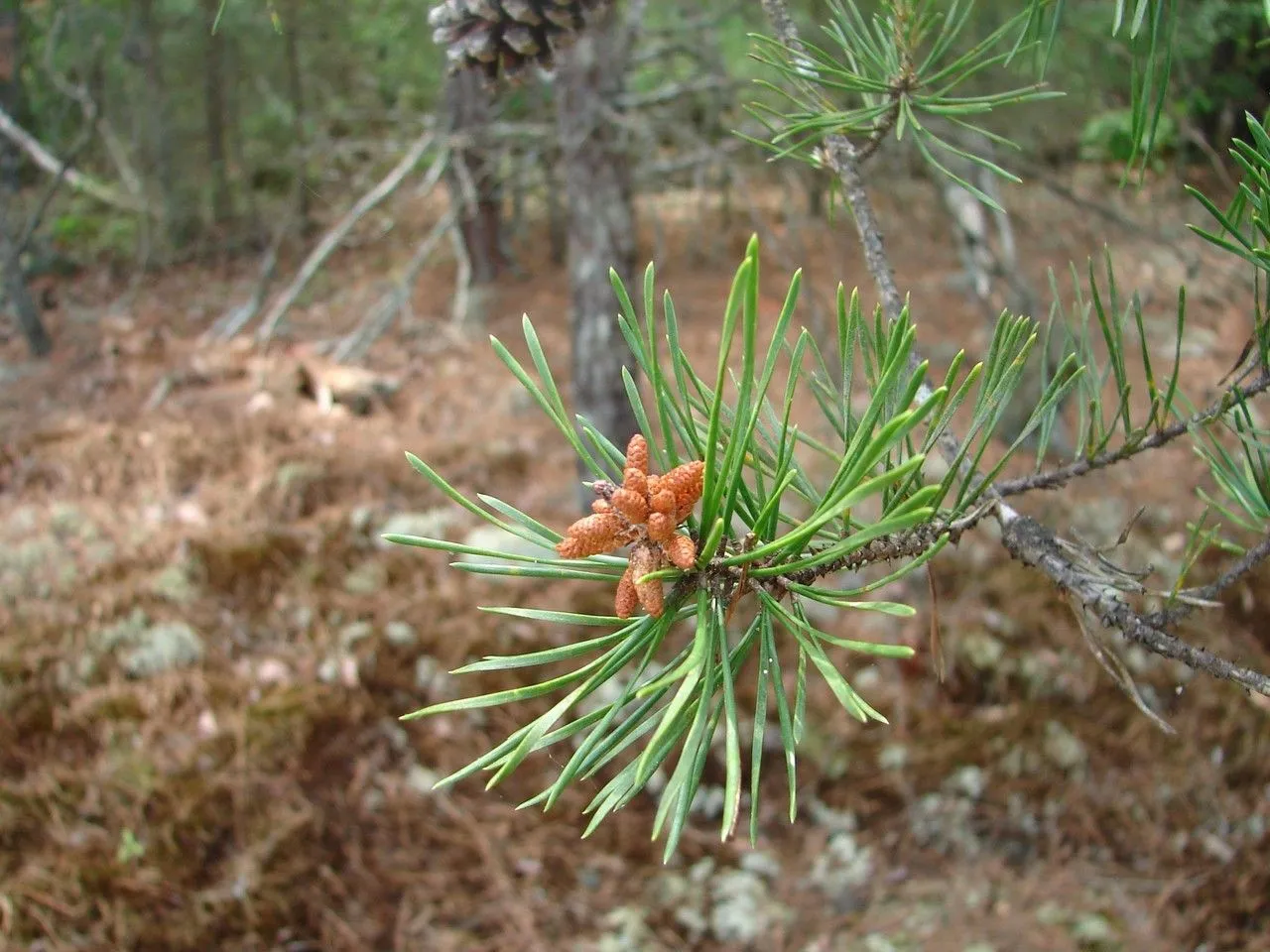
Author: Mill.
Bibliography: Gard. Dict. ed. 8: n.º 9 (1768)
Year: 1768
Status: accepted
Rank: species
Genus: Pinus
Vegetable: False
Observations: E. U.S.A.
Scrub pine, scientifically known as Pinus virginiana, is a resilient and adaptable pine species native to the eastern United States. First documented in the 8th edition of the Gardener’s Dictionary by Philip Miller in 1768, this tree has since been a significant part of the North American flora.
Scrub pine is a member of the Pinaceae family, which encompasses a wide range of coniferous trees known for their economic and ecological importance. This species can be identified by its characteristic needles, typically growing in pairs and often displaying a twisted form. The needles are a distinctive yellow-green, contributing to the tree’s somewhat scruffy appearance, which gives rise to its common name.
Adapted to survive in poor soils and challenging environmental conditions, Pinus virginiana thrives particularly well in dry, sandy, and rocky terrains where other tree species might struggle. This hearty nature makes it an essential species for reforestation and land reclamation projects, as it helps to stabilize soils and create habitats for various wildlife.
One of the defining features of the scrub pine is its versatility in height. Depending on the conditions, it can range from small, shrubby forms to more robust trees reaching up to 50 feet in height. The bark of Pinus virginiana is typically thin and scaly, with a reddish-brown hue that becomes more pronounced with age.
The cones of scrub pine are another notable feature, maturing at around two inches in length and taking approximately two years to open fully. These cones release seeds that are a food source for several bird and small mammal species, thus playing a vital role in the local ecosystem.
In landscapes, Pinus virginiana serves multiple purposes beyond its ecological benefits. It is often utilized in ornamental plantings for its unique appearance and ability to grow in less-than-ideal soil conditions. Additionally, it has historical significance for its use in construction, especially for rustic buildings and fence posts.
In summary, scrub pine (Pinus virginiana) is a resilient tree native to the eastern United States, valued for its adaptability to poor soil conditions and its ecological benefits. Documented extensively since the 18th century, this member of the Pinaceae family continues to be a critical species for both natural habitats and managed landscapes.
Eng: jersey pine, poverty pine, scrub pine, virginia pine, old field pine, shortstraw pine
Deu: jersey-kiefer, virginische kiefer
Ita: pino della virginia
Hun: virginiai erdeifenyo
Fra: pin de jersey, pin de virginie, pin de la virginie
Swe: virginiatall
Rus: сосна виргинская (sosna virginskaya)
Zho: 矮松 (ai song)
En: Scrub pine, Virginia pine, Jersey pine, Poverty pine, Old field pine, Shortstraw pine
Bg: Вирджински бор
Zh: Ai song, 矮松, 矮松 (ai song)
Cs: Borovice virginská
Et: Virgiinia mänd
Fi: Virginianmänty
Fr: Pin de Virginie, Pin de Jersey, Pin de la Virginie
De: Jersey-Kiefer, Virginische Kiefer
Hu: Virginiai erdeifenyo
Is: Tígulfura
It: Pino della Virginia
Kv: Виргинияись пожум
Fa: کاج ویرجینیایی
Pl: Sosna wirginijska
Ru: Сосна виргинская, Сосна виргинская (sosna virginskaya)
Sv: Virginiatall
Zh-hant: 矮松
Taken Apr 20, 2004 by EOL − Steven J. Baskauf (cc-by-nc-sa)
Taken Jan 1, 1900 by EOL − Gerrit Davidse (cc-by-nc-sa)
Taken Jan 1, 1900 by EOL − Gerrit Davidse (cc-by-nc-sa)
Taken Jan 1, 1900 by EOL − Gerrit Davidse (cc-by-nc-sa)
Taken Apr 3, 2022 by Omid Jahed (cc-by-sa)
Taken Jul 3, 2002 by EOL − Steven J. Baskauf (cc-by-nc-sa)
Taken Jan 9, 2022 by Adam Borneman (cc-by-sa)
Taken Apr 28, 2019 by Hannah Bates (cc-by-sa)
Taken Jan 9, 2022 by Adam Borneman (cc-by-sa)
Taken Feb 17, 2021 by Rachel Ghent (cc-by-sa)
Taken Sep 24, 2022 by RIVER STONE (cc-by-sa)
Taken Nov 16, 2020 by Raphael Gomes (cc-by-sa)
Taken Jan 1, 1900 by EOL − Photo Derek Ramsey (Ram-Man) (cc-by-sa)
Taken Jul 3, 2002 by EOL − Steven J. Baskauf (cc-by-nc-sa)
Taken Feb 17, 2021 by Rachel Ghent (cc-by-sa)
© copyright of the Board of Trustees of the Royal Botanic Gardens, Kew.
Taken May 22, 2015 by EOL − andrew_ault3 (cc-by-nc)
Taken Feb 8, 2016 by EOL − Jonathan Carpenter (cc-by-nc)
Taken Apr 15, 2006 by EOL − Steven J. Baskauf (cc-by-nc-sa)
Taken Apr 15, 2006 by EOL − Steven J. Baskauf (cc-by-nc-sa)
Taken Aug 6, 2020 by formatique alain (cc-by-sa)
Taken May 10, 2006 by EOL − Martin LaBar (cc-by-nc)
Taken Jan 1, 1900 by EOL − bobistraveling (cc-by)
Taken Apr 15, 2006 by EOL − Steven J. Baskauf (cc-by-nc-sa)
Taken Jan 1, 1900 by EOL − bobistraveling (cc-by)
Taken Jan 1, 1900 by EOL − Peter Leitheiser (public)
Growth form>: Single Stem
Growth habit>: Tree
Growth rate>: Rapid
Ph maximum: 7.5
Ph minimum: 4.5
Family: Myrtaceae Author: (F.Muell.) K.D.Hill & L.A.S.Johnson Bibliography: Telopea 6: 402 (1995) Year: 1995 Status:…
Family: Rubiaceae Author: Pierre ex A.Froehner Bibliography: Notizbl. Bot. Gart. Berlin-Dahlem 1: 237 (1897) Year:…
Family: Sapindaceae Author: Koidz. Bibliography: J. Coll. Sci. Imp. Univ. Tokyo 32(1): 38 (1911) Year:…
Family: Asteraceae Author: A.Gray Bibliography: Pacif. Railr. Rep.: 107 (1857) Year: 1857 Status: accepted Rank:…
Family: Fabaceae Author: Medik. Bibliography: Vorles. Churpfälz. Phys.-Ökon. Ges. 2: 398 (1787) Year: 1787 Status:…
Family: Aspleniaceae Author: (Cav.) Alston Bibliography: Bull. Misc. Inform. Kew 1932: 309 (1932) Year: 1932…